automatic transmission fluid FORD E SERIES 2023 Owners Manual
[x] Cancel search | Manufacturer: FORD, Model Year: 2023, Model line: E SERIES, Model: FORD E SERIES 2023Pages: 292, PDF Size: 6.81 MB
Page 6 of 292
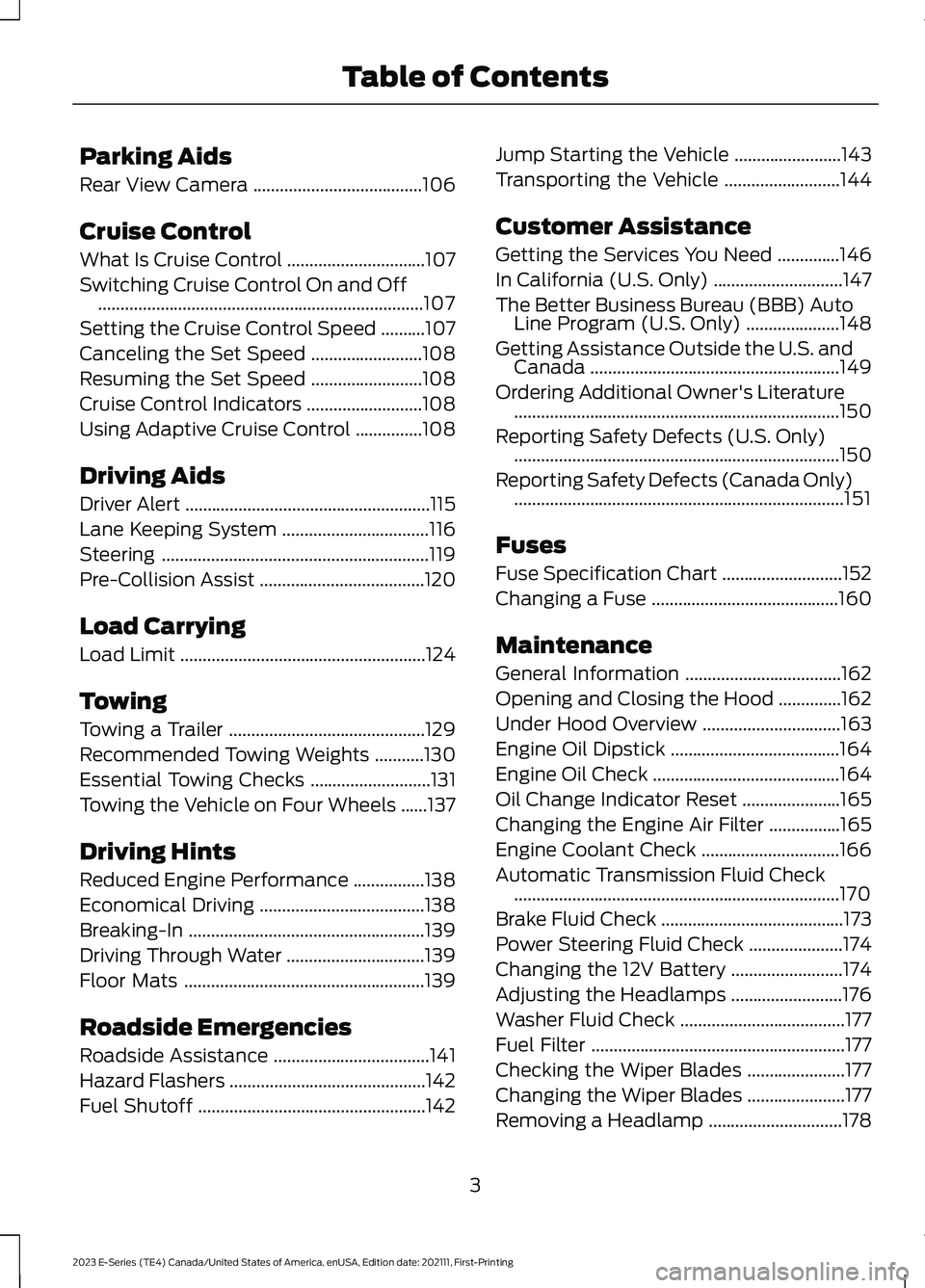
Parking Aids
Rear View Camera......................................106
Cruise Control
What Is Cruise Control...............................107
Switching Cruise Control On and Off.........................................................................107
Setting the Cruise Control Speed..........107
Canceling the Set Speed.........................108
Resuming the Set Speed.........................108
Cruise Control Indicators..........................108
Using Adaptive Cruise Control...............108
Driving Aids
Driver Alert.......................................................115
Lane Keeping System.................................116
Steering............................................................119
Pre-Collision Assist.....................................120
Load Carrying
Load Limit.......................................................124
Towing
Towing a Trailer............................................129
Recommended Towing Weights...........130
Essential Towing Checks...........................131
Towing the Vehicle on Four Wheels......137
Driving Hints
Reduced Engine Performance................138
Economical Driving.....................................138
Breaking-In.....................................................139
Driving Through Water...............................139
Floor Mats......................................................139
Roadside Emergencies
Roadside Assistance...................................141
Hazard Flashers............................................142
Fuel Shutoff...................................................142
Jump Starting the Vehicle........................143
Transporting the Vehicle..........................144
Customer Assistance
Getting the Services You Need..............146
In California (U.S. Only).............................147
The Better Business Bureau (BBB) AutoLine Program (U.S. Only).....................148
Getting Assistance Outside the U.S. andCanada........................................................149
Ordering Additional Owner's Literature.........................................................................150
Reporting Safety Defects (U.S. Only).........................................................................150
Reporting Safety Defects (Canada Only)..........................................................................151
Fuses
Fuse Specification Chart...........................152
Changing a Fuse..........................................160
Maintenance
General Information...................................162
Opening and Closing the Hood..............162
Under Hood Overview...............................163
Engine Oil Dipstick......................................164
Engine Oil Check..........................................164
Oil Change Indicator Reset......................165
Changing the Engine Air Filter................165
Engine Coolant Check...............................166
Automatic Transmission Fluid Check.........................................................................170
Brake Fluid Check.........................................173
Power Steering Fluid Check.....................174
Changing the 12V Battery.........................174
Adjusting the Headlamps.........................176
Washer Fluid Check.....................................177
Fuel Filter.........................................................177
Checking the Wiper Blades......................177
Changing the Wiper Blades......................177
Removing a Headlamp..............................178
3
2023 E-Series (TE4) Canada/United States of America, enUSA, Edition date: 202111, First-PrintingTable of Contents
Page 7 of 292
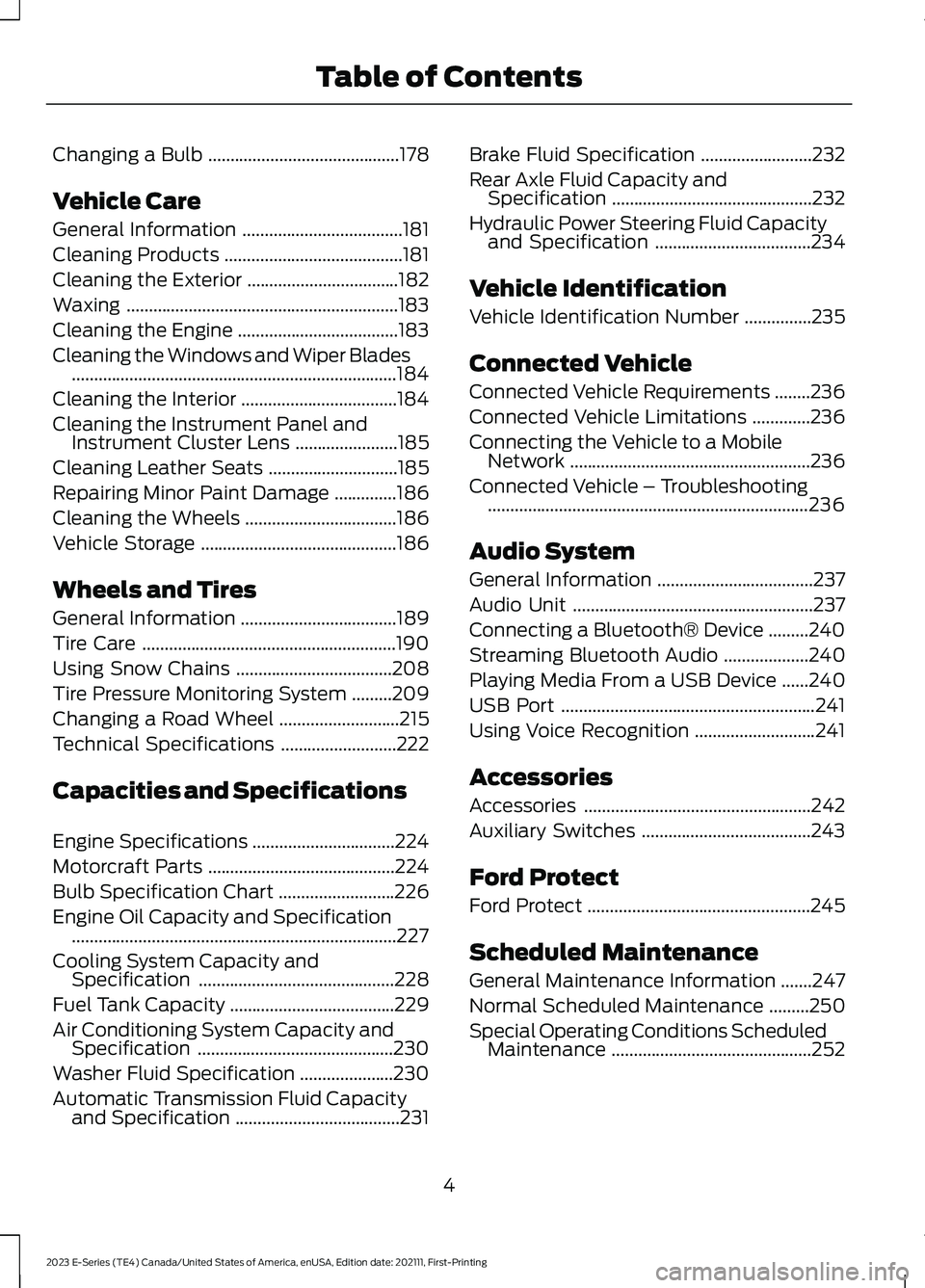
Changing a Bulb...........................................178
Vehicle Care
General Information....................................181
Cleaning Products........................................181
Cleaning the Exterior..................................182
Waxing.............................................................183
Cleaning the Engine....................................183
Cleaning the Windows and Wiper Blades.........................................................................184
Cleaning the Interior...................................184
Cleaning the Instrument Panel andInstrument Cluster Lens.......................185
Cleaning Leather Seats.............................185
Repairing Minor Paint Damage..............186
Cleaning the Wheels..................................186
Vehicle Storage............................................186
Wheels and Tires
General Information...................................189
Tire Care.........................................................190
Using Snow Chains...................................208
Tire Pressure Monitoring System.........209
Changing a Road Wheel...........................215
Technical Specifications..........................222
Capacities and Specifications
Engine Specifications................................224
Motorcraft Parts..........................................224
Bulb Specification Chart..........................226
Engine Oil Capacity and Specification.........................................................................227
Cooling System Capacity andSpecification............................................228
Fuel Tank Capacity.....................................229
Air Conditioning System Capacity andSpecification............................................230
Washer Fluid Specification.....................230
Automatic Transmission Fluid Capacityand Specification.....................................231
Brake Fluid Specification.........................232
Rear Axle Fluid Capacity andSpecification.............................................232
Hydraulic Power Steering Fluid Capacityand Specification...................................234
Vehicle Identification
Vehicle Identification Number...............235
Connected Vehicle
Connected Vehicle Requirements........236
Connected Vehicle Limitations.............236
Connecting the Vehicle to a MobileNetwork......................................................236
Connected Vehicle – Troubleshooting........................................................................236
Audio System
General Information...................................237
Audio Unit......................................................237
Connecting a Bluetooth® Device.........240
Streaming Bluetooth Audio...................240
Playing Media From a USB Device......240
USB Port.........................................................241
Using Voice Recognition...........................241
Accessories
Accessories...................................................242
Auxiliary Switches......................................243
Ford Protect
Ford Protect..................................................245
Scheduled Maintenance
General Maintenance Information.......247
Normal Scheduled Maintenance.........250
Special Operating Conditions ScheduledMaintenance.............................................252
4
2023 E-Series (TE4) Canada/United States of America, enUSA, Edition date: 202111, First-PrintingTable of Contents
Page 166 of 292

UNDER HOOD OVERVIEW
Windshield washer fluid reservoir. See Washer Fluid Check (page 177).A
Automatic transmission fluid dipstick. See Automatic Transmission FluidCheck (page 170).B
Engine oil dipstick. See Engine Oil Dipstick (page 164).C
Air cleaner assembly. See Changing the Engine Air Filter (page 165).D
Engine oil filler cap. See Engine Oil Check (page 164).E
Brake fluid reservoir. See Brake Fluid Check (page 173).F
Engine coolant reservoir. See Engine Coolant Check (page 166).G
Engine compartment fuse box. See Fuses (page 152).H
Power steering fluid reservoir. See Power Steering Fluid Check (page 174).I
Battery. See Changing the 12V Battery (page 174).J
163
2023 E-Series (TE4) Canada/United States of America, enUSA, Edition date: 202111, First-PrintingMaintenanceE312299
Page 173 of 292
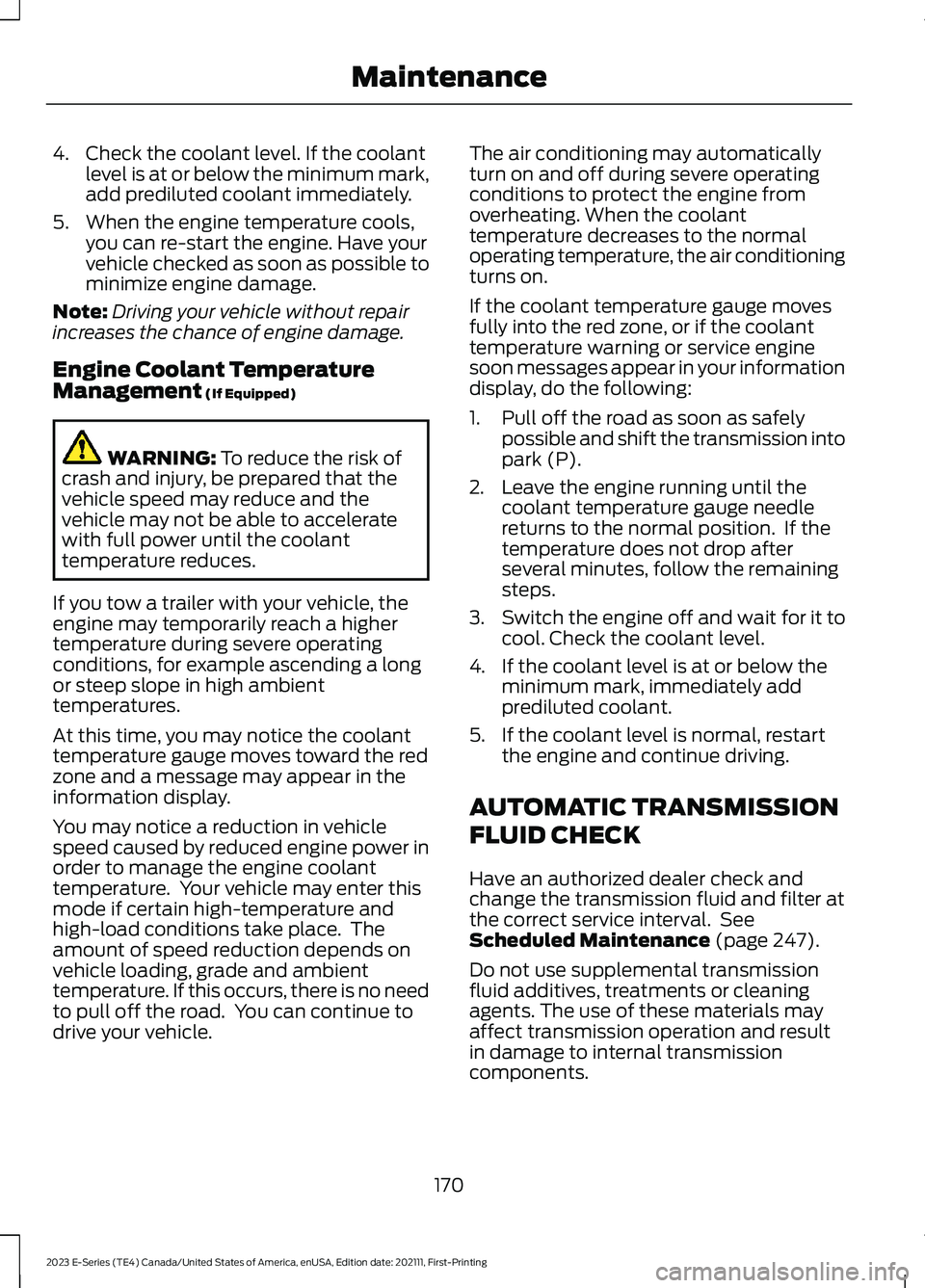
4.Check the coolant level. If the coolantlevel is at or below the minimum mark,add prediluted coolant immediately.
5.When the engine temperature cools,you can re-start the engine. Have yourvehicle checked as soon as possible tominimize engine damage.
Note:Driving your vehicle without repairincreases the chance of engine damage.
Engine Coolant TemperatureManagement (If Equipped)
WARNING: To reduce the risk ofcrash and injury, be prepared that thevehicle speed may reduce and thevehicle may not be able to acceleratewith full power until the coolanttemperature reduces.
If you tow a trailer with your vehicle, theengine may temporarily reach a highertemperature during severe operatingconditions, for example ascending a longor steep slope in high ambienttemperatures.
At this time, you may notice the coolanttemperature gauge moves toward the redzone and a message may appear in theinformation display.
You may notice a reduction in vehiclespeed caused by reduced engine power inorder to manage the engine coolanttemperature. Your vehicle may enter thismode if certain high-temperature andhigh-load conditions take place. Theamount of speed reduction depends onvehicle loading, grade and ambienttemperature. If this occurs, there is no needto pull off the road. You can continue todrive your vehicle.
The air conditioning may automaticallyturn on and off during severe operatingconditions to protect the engine fromoverheating. When the coolanttemperature decreases to the normaloperating temperature, the air conditioningturns on.
If the coolant temperature gauge movesfully into the red zone, or if the coolanttemperature warning or service enginesoon messages appear in your informationdisplay, do the following:
1.Pull off the road as soon as safelypossible and shift the transmission intopark (P).
2.Leave the engine running until thecoolant temperature gauge needlereturns to the normal position. If thetemperature does not drop afterseveral minutes, follow the remainingsteps.
3.Switch the engine off and wait for it tocool. Check the coolant level.
4.If the coolant level is at or below theminimum mark, immediately addprediluted coolant.
5.If the coolant level is normal, restartthe engine and continue driving.
AUTOMATIC TRANSMISSION
FLUID CHECK
Have an authorized dealer check andchange the transmission fluid and filter atthe correct service interval. SeeScheduled Maintenance (page 247).
Do not use supplemental transmissionfluid additives, treatments or cleaningagents. The use of these materials mayaffect transmission operation and resultin damage to internal transmissioncomponents.
170
2023 E-Series (TE4) Canada/United States of America, enUSA, Edition date: 202111, First-PrintingMaintenance
Page 174 of 292
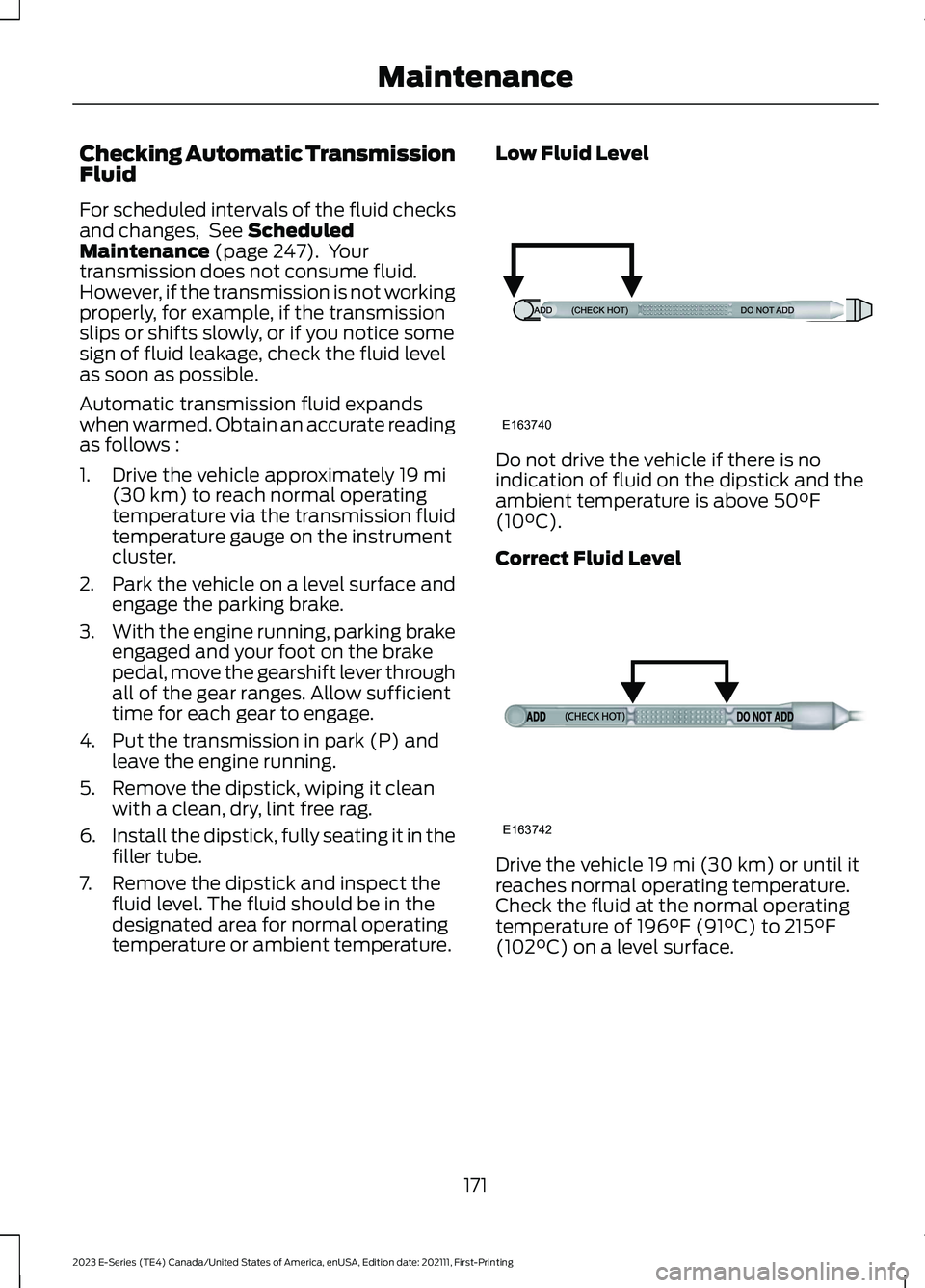
Checking Automatic TransmissionFluid
For scheduled intervals of the fluid checksand changes, See ScheduledMaintenance (page 247). Yourtransmission does not consume fluid.However, if the transmission is not workingproperly, for example, if the transmissionslips or shifts slowly, or if you notice somesign of fluid leakage, check the fluid levelas soon as possible.
Automatic transmission fluid expandswhen warmed. Obtain an accurate readingas follows :
1.Drive the vehicle approximately 19 mi(30 km) to reach normal operatingtemperature via the transmission fluidtemperature gauge on the instrumentcluster.
2.Park the vehicle on a level surface andengage the parking brake.
3.With the engine running, parking brakeengaged and your foot on the brakepedal, move the gearshift lever throughall of the gear ranges. Allow sufficienttime for each gear to engage.
4.Put the transmission in park (P) andleave the engine running.
5.Remove the dipstick, wiping it cleanwith a clean, dry, lint free rag.
6.Install the dipstick, fully seating it in thefiller tube.
7.Remove the dipstick and inspect thefluid level. The fluid should be in thedesignated area for normal operatingtemperature or ambient temperature.
Low Fluid Level
Do not drive the vehicle if there is noindication of fluid on the dipstick and theambient temperature is above 50°F(10°C).
Correct Fluid Level
Drive the vehicle 19 mi (30 km) or until itreaches normal operating temperature.Check the fluid at the normal operatingtemperature of 196°F (91°C) to 215°F(102°C) on a level surface.
171
2023 E-Series (TE4) Canada/United States of America, enUSA, Edition date: 202111, First-PrintingMaintenanceE163740 E163742
Page 175 of 292
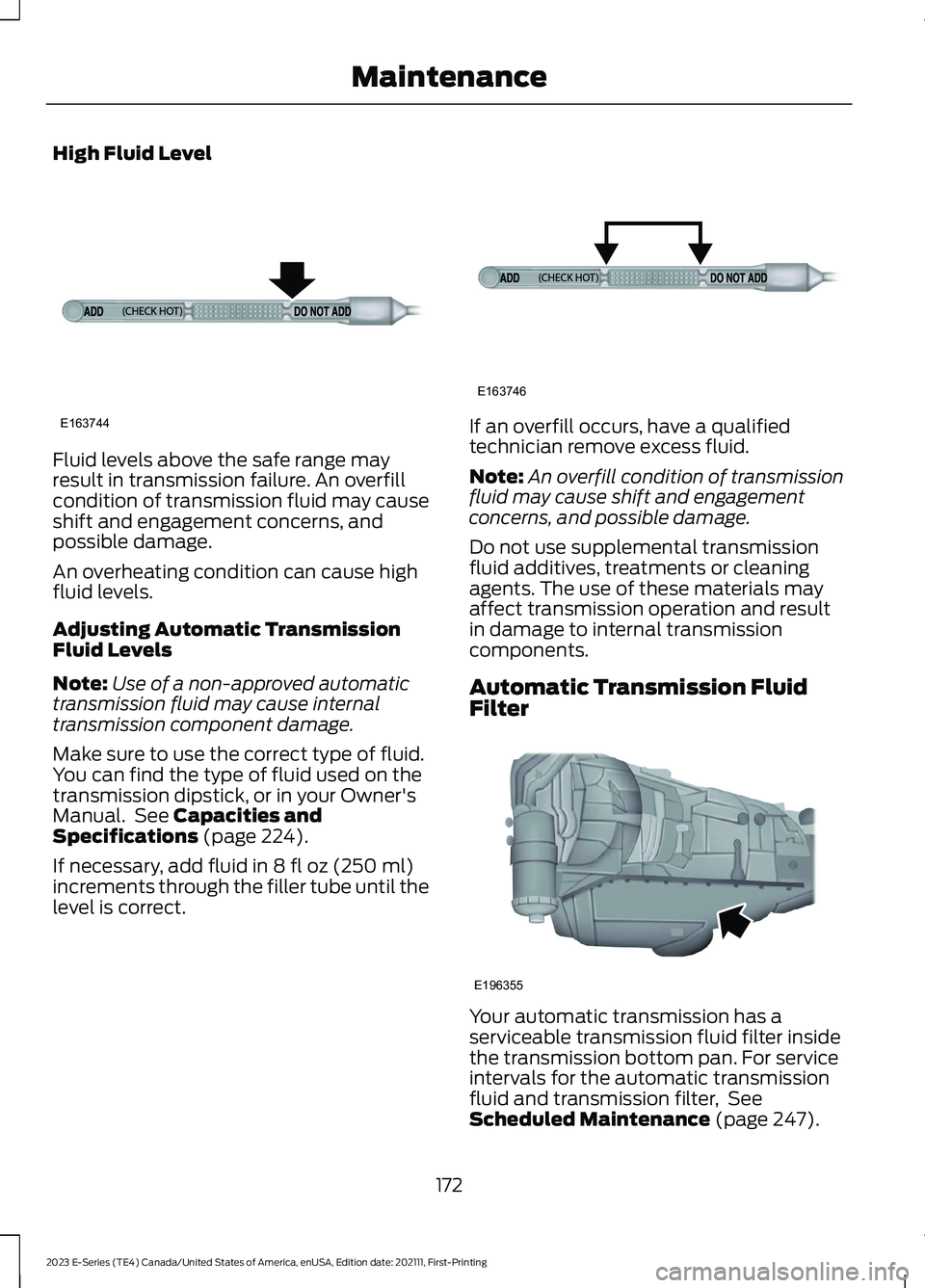
High Fluid Level
Fluid levels above the safe range mayresult in transmission failure. An overfillcondition of transmission fluid may causeshift and engagement concerns, andpossible damage.
An overheating condition can cause highfluid levels.
Adjusting Automatic TransmissionFluid Levels
Note:Use of a non-approved automatictransmission fluid may cause internaltransmission component damage.
Make sure to use the correct type of fluid.You can find the type of fluid used on thetransmission dipstick, or in your Owner'sManual. See Capacities andSpecifications (page 224).
If necessary, add fluid in 8 fl oz (250 ml)increments through the filler tube until thelevel is correct.
If an overfill occurs, have a qualifiedtechnician remove excess fluid.
Note:An overfill condition of transmissionfluid may cause shift and engagementconcerns, and possible damage.
Do not use supplemental transmissionfluid additives, treatments or cleaningagents. The use of these materials mayaffect transmission operation and resultin damage to internal transmissioncomponents.
Automatic Transmission FluidFilter
Your automatic transmission has aserviceable transmission fluid filter insidethe transmission bottom pan. For serviceintervals for the automatic transmissionfluid and transmission filter, SeeScheduled Maintenance (page 247).
172
2023 E-Series (TE4) Canada/United States of America, enUSA, Edition date: 202111, First-PrintingMaintenanceE163744 E163746 E196355
Page 234 of 292
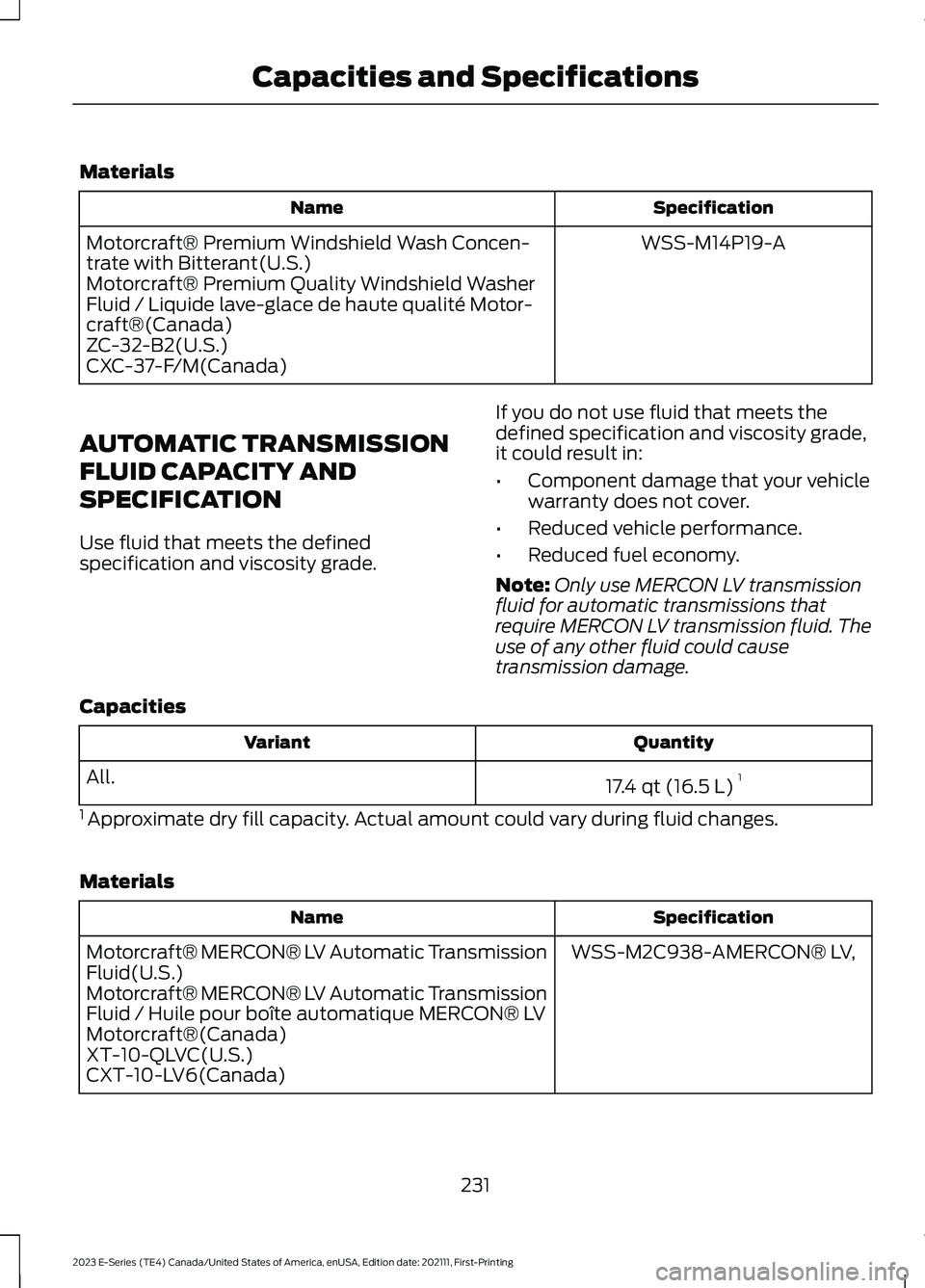
Materials
SpecificationName
WSS-M14P19-AMotorcraft® Premium Windshield Wash Concen-trate with Bitterant(U.S.)Motorcraft® Premium Quality Windshield WasherFluid / Liquide lave-glace de haute qualité Motor-craft®(Canada)ZC-32-B2(U.S.)CXC-37-F/M(Canada)
AUTOMATIC TRANSMISSION
FLUID CAPACITY AND
SPECIFICATION
Use fluid that meets the definedspecification and viscosity grade.
If you do not use fluid that meets thedefined specification and viscosity grade,it could result in:
•Component damage that your vehiclewarranty does not cover.
•Reduced vehicle performance.
•Reduced fuel economy.
Note:Only use MERCON LV transmissionfluid for automatic transmissions thatrequire MERCON LV transmission fluid. Theuse of any other fluid could causetransmission damage.
Capacities
QuantityVariant
17.4 qt (16.5 L)1All.
1 Approximate dry fill capacity. Actual amount could vary during fluid changes.
Materials
SpecificationName
WSS-M2C938-AMERCON® LV,Motorcraft® MERCON® LV Automatic TransmissionFluid(U.S.)Motorcraft® MERCON® LV Automatic TransmissionFluid / Huile pour boîte automatique MERCON® LVMotorcraft®(Canada)XT-10-QLVC(U.S.)CXT-10-LV6(Canada)
231
2023 E-Series (TE4) Canada/United States of America, enUSA, Edition date: 202111, First-PrintingCapacities and Specifications
Page 237 of 292
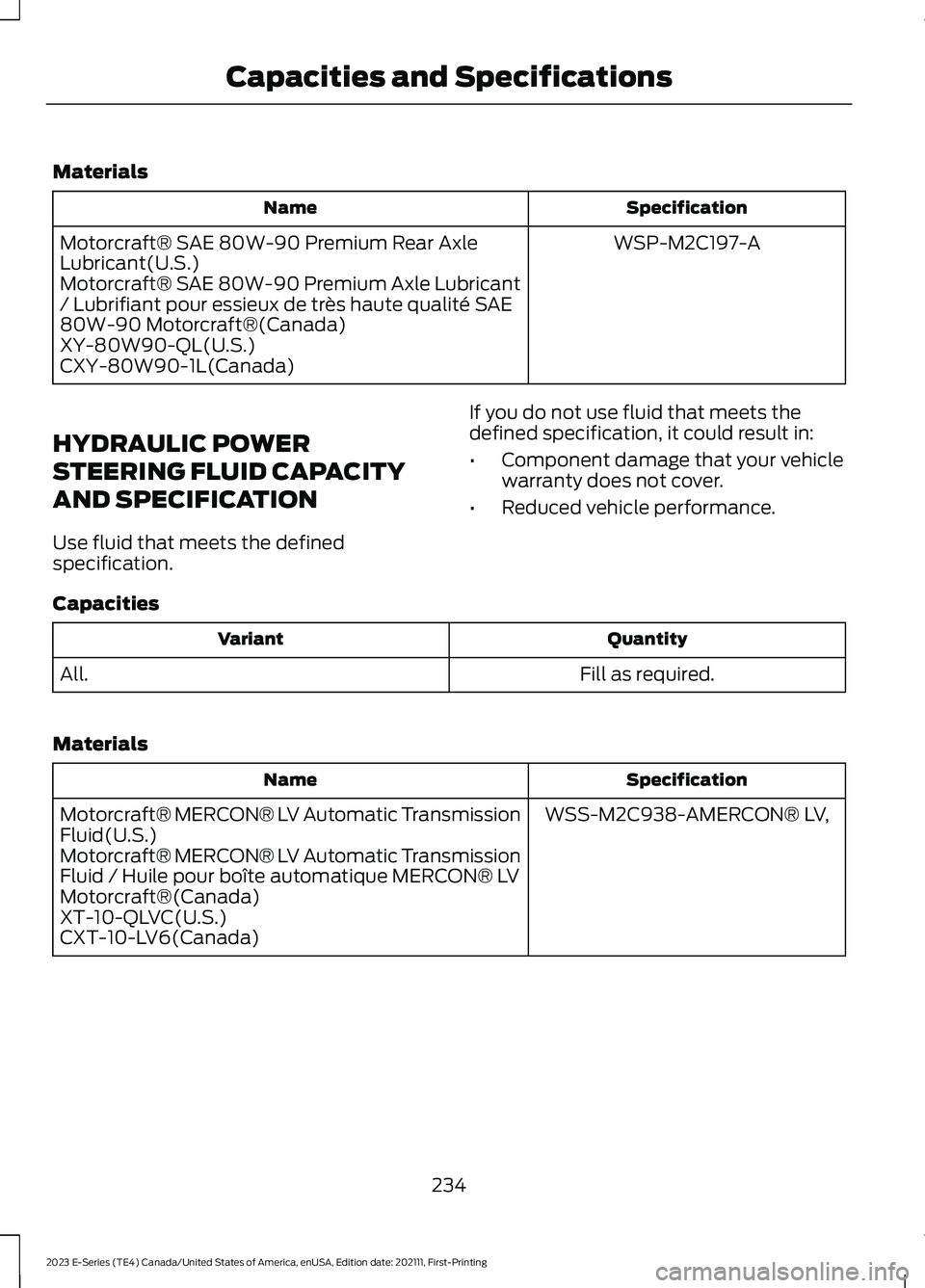
Materials
SpecificationName
WSP-M2C197-AMotorcraft® SAE 80W-90 Premium Rear AxleLubricant(U.S.)Motorcraft® SAE 80W-90 Premium Axle Lubricant/ Lubrifiant pour essieux de très haute qualité SAE80W-90 Motorcraft®(Canada)XY-80W90-QL(U.S.)CXY-80W90-1L(Canada)
HYDRAULIC POWER
STEERING FLUID CAPACITY
AND SPECIFICATION
Use fluid that meets the definedspecification.
If you do not use fluid that meets thedefined specification, it could result in:
•Component damage that your vehiclewarranty does not cover.
•Reduced vehicle performance.
Capacities
QuantityVariant
Fill as required.All.
Materials
SpecificationName
WSS-M2C938-AMERCON® LV,Motorcraft® MERCON® LV Automatic TransmissionFluid(U.S.)Motorcraft® MERCON® LV Automatic TransmissionFluid / Huile pour boîte automatique MERCON® LVMotorcraft®(Canada)XT-10-QLVC(U.S.)CXT-10-LV6(Canada)
234
2023 E-Series (TE4) Canada/United States of America, enUSA, Edition date: 202111, First-PrintingCapacities and Specifications
Page 252 of 292
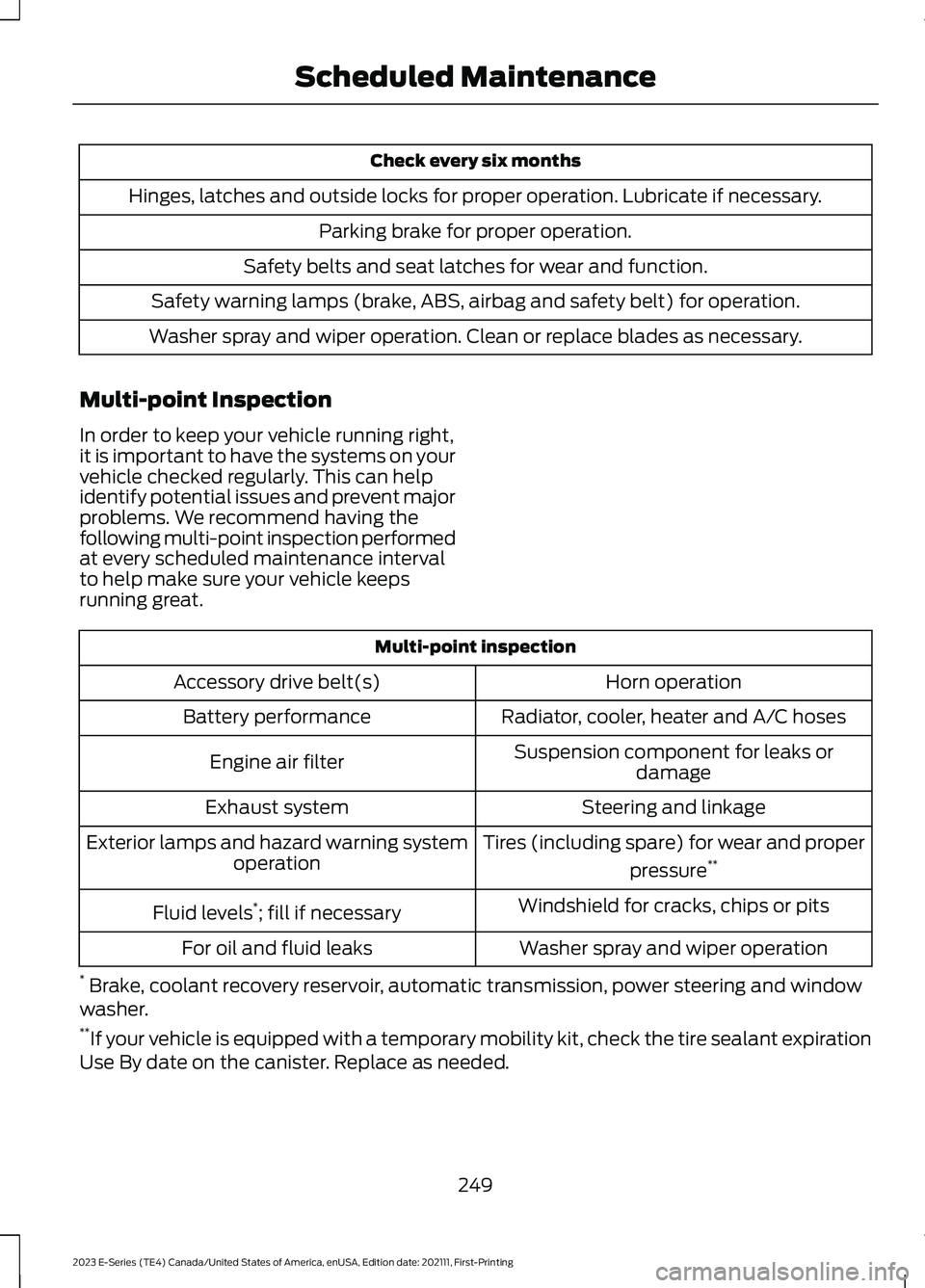
Check every six months
Hinges, latches and outside locks for proper operation. Lubricate if necessary.
Parking brake for proper operation.
Safety belts and seat latches for wear and function.
Safety warning lamps (brake, ABS, airbag and safety belt) for operation.
Washer spray and wiper operation. Clean or replace blades as necessary.
Multi-point Inspection
In order to keep your vehicle running right,it is important to have the systems on yourvehicle checked regularly. This can helpidentify potential issues and prevent majorproblems. We recommend having thefollowing multi-point inspection performedat every scheduled maintenance intervalto help make sure your vehicle keepsrunning great.
Multi-point inspection
Horn operationAccessory drive belt(s)
Radiator, cooler, heater and A/C hosesBattery performance
Suspension component for leaks ordamageEngine air filter
Steering and linkageExhaust system
Tires (including spare) for wear and proper
pressure**Exterior lamps and hazard warning systemoperation
Windshield for cracks, chips or pitsFluid levels*; fill if necessary
Washer spray and wiper operationFor oil and fluid leaks
* Brake, coolant recovery reservoir, automatic transmission, power steering and windowwasher.**If your vehicle is equipped with a temporary mobility kit, check the tire sealant expirationUse By date on the canister. Replace as needed.
249
2023 E-Series (TE4) Canada/United States of America, enUSA, Edition date: 202111, First-PrintingScheduled Maintenance
Page 253 of 292
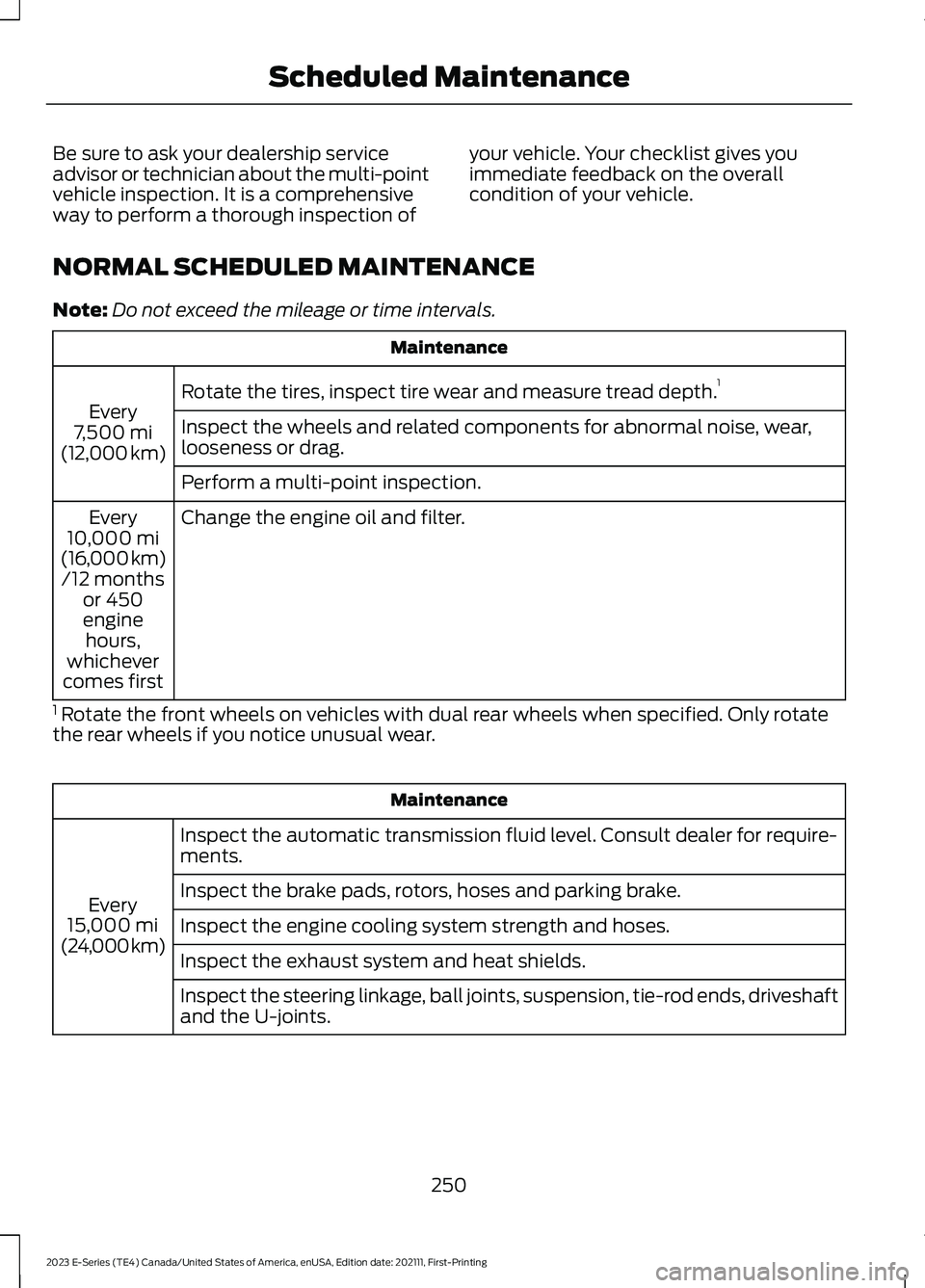
Be sure to ask your dealership serviceadvisor or technician about the multi-pointvehicle inspection. It is a comprehensiveway to perform a thorough inspection of
your vehicle. Your checklist gives youimmediate feedback on the overallcondition of your vehicle.
NORMAL SCHEDULED MAINTENANCE
Note:Do not exceed the mileage or time intervals.
Maintenance
Rotate the tires, inspect tire wear and measure tread depth.1
Every7,500 mi(12,000 km)
Inspect the wheels and related components for abnormal noise, wear,looseness or drag.
Perform a multi-point inspection.
Change the engine oil and filter.Every10,000 mi(16,000 km)/12 monthsor 450enginehours,whichevercomes first
1 Rotate the front wheels on vehicles with dual rear wheels when specified. Only rotatethe rear wheels if you notice unusual wear.
Maintenance
Inspect the automatic transmission fluid level. Consult dealer for require-ments.
Every15,000 mi(24,000 km)
Inspect the brake pads, rotors, hoses and parking brake.
Inspect the engine cooling system strength and hoses.
Inspect the exhaust system and heat shields.
Inspect the steering linkage, ball joints, suspension, tie-rod ends, driveshaftand the U-joints.
250
2023 E-Series (TE4) Canada/United States of America, enUSA, Edition date: 202111, First-PrintingScheduled Maintenance